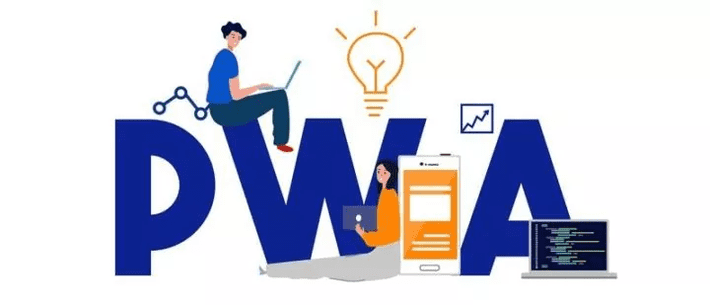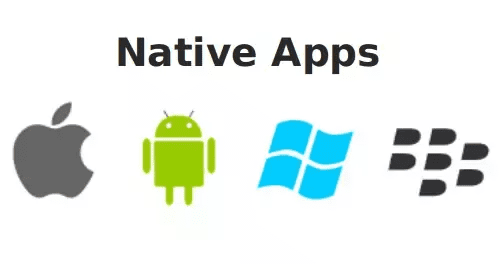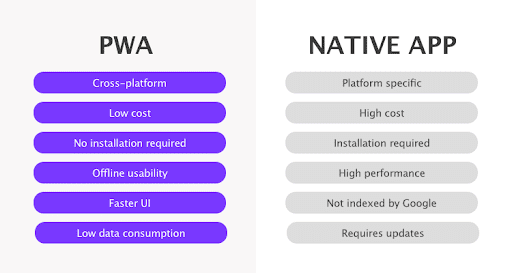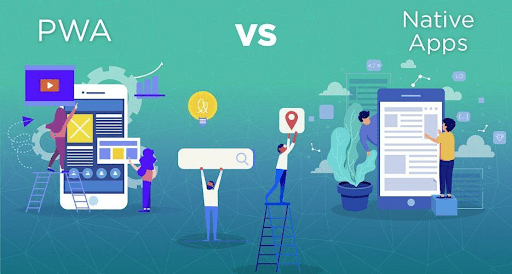
Progressive web apps have been a success since their onset. PWAs load faster than other apps and they are smaller in size too. Did you know Uber’s PWA takes just 3 seconds to load on the 2G network?
Here are some other examples which show how incredible PWAs are:
- The engagements of Pinterest increased by 60% after they rebuilt their mobile site into a PWA.
- The loading time of Tinder has decreased to 4.69 seconds from 11.91 seconds.
- Bookmyshow’s PWA is 108 times smaller than its iOS apps and 54 times smaller than Android.
Do you know how PWAs make all this possible? Before answering this query, let us understand the meaning of PWAs:

Progressive web apps are developed by using modern technologies like HTML, CSS, and Javascript. These apps are websites that provide a native-like experience. In a nutshell, they are web apps.
PWAs are known for working on a script that is known as a Service worker which runs in the background and independent of the website. This provides periodic background syncs, push notifications, and rich office experiences.
For app developers, it is easy to develop these apps as they do not need to learn a new programming language unlike in the case of native apps. There is no requirement to install a development environment as all modern browsers support PWAs.
Benefits of PWAs: Progressive web apps provide high speed, reliability, less loading time, and excellent user engagement.
Undoubtedly, progressive web apps are advantageous. According to the few statistics cited above, they are better than native apps too. Let’s understand the meaning of native apps before finding the difference Native apps vs PWAs.

The native application is a term that is used irreplaceably with iOS and Android apps or all other kinds of mobile apps. These apps are built for a specific platform and coded with a separate programming language.
This allows them to function seamlessly on the specific operating system as they utilize its tools and frameworks. When an android app developer chooses a platform (android) for which they are going to develop an app, they work according to the unique capabilities of that hardware.
The benefits of native apps include robust security features, less battery consumption, and uncomplicated app store visibility.
After reading about the two types of applications in brief, which of them do you think is a better app for your business?
Let’s compare these apps according to the business point of view.
PWA vs Native app #1: User experience
PWA allows you to provide the same interface in the browser and the app which is installed on the device. It eliminates the requirement for learning more than one interface. On the other hand, native apps require more storage space. This impacts the users who have limited space in their smartphones. It hampers their user experience
.
PWA vs Native app #2: Security
Unlike PWAs, Native apps have access to all the necessary information on the device. These applications have embed Transport layer security (TLS) certificates which ensure high security. In the case of PWAs, the apps require their own certifications.
PWA vs Native app #3: Loading speed
PWA offers a faster loading speed even when the device is not connected to the internet. This is because they use the service worker script for caching, managing requests, and storing shell data. Loading speed is one of the primary reasons behind engagement and retention rates. Therefore, PWA has an upper hand on native apps under this parameter.
PWA vs Native app #4: App store visibility
PWAs have a more complicated process of getting published on an app store. With PWAs, you will have to give a short note about the native capabilities. Moreover, there should be a valid proof that you are a registered and legal business. Native apps do not have to complete these formalities to get visible in the app store.
PWA vs Native app #5: Development cost
Time to develop PWAs by any web application development company in India is quite less which reduces the overall development cost. On the other hand, the development cost of native apps is more as the developers have to spend more time and effort on updating the apps according to the new features of the operating system.
PWA vs Native app #6: Online visibility
Although it has been shared above that it is easy to make native apps visible in the app store. But PWAs are easy to make visible online because of the nature with which they are made. As the PWAs are made as website imitating app. So, you can find these apps over the web and their visibility is not limited to the app store.

Conclusion: What should you choose: Native app or PWA?
- As an entrepreneur, you should consider building PWA if you are looking for a basic app for the users. It will not require your user to download the apps and it will be easy to interact with them through push notifications.
- In case you have time constraints and you want to save your costs, then PWA is a good option as it takes less time and cost to develop progressive web apps.
- PWA has the capability to reach a wider audience, so if you are looking for an app to increase your brand awareness then these apps are a good option for you.
- If you are looking for an app that can add reliability then native apps can serve that purpose. As native apps are known to offer greater security.
- Native apps can provide greater computing power and better UX options like geo-fencing and sensor/detection.
Based on the above points, you can decide whether you have to get a native app or PWA. make sure to take a decision after analyzing the needs of your business. Both types of apps are efficient but the purposes they satisfy are different.
